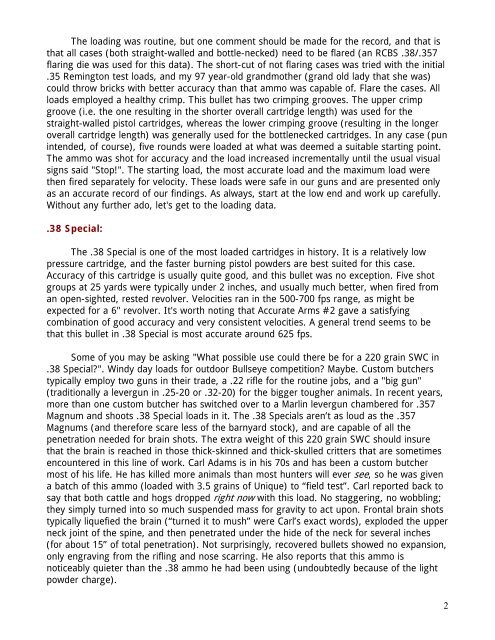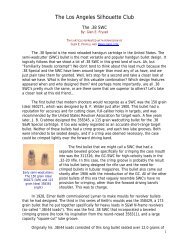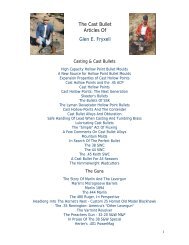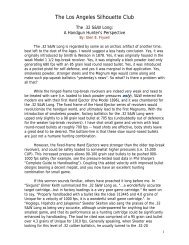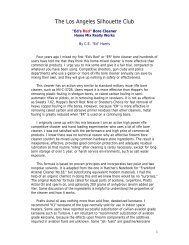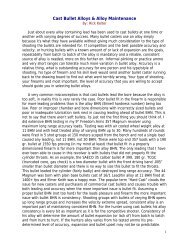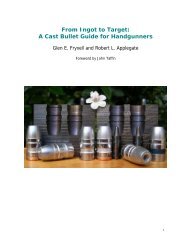Create successful ePaper yourself
Turn your PDF publications into a flip-book with our unique Google optimized e-Paper software.
The loading was routine, but one comment should be made for the record, and that is<br />
that all cases (both straight-walled and bottle-necked) need to be flared (an RCBS .38/.357<br />
flaring die was used for this data). The short-cut of not flaring cases was tried with the initial<br />
.35 Remington test loads, and my 97 year-old grandmother (grand old lady that she was)<br />
could throw bricks with better accuracy than that ammo was capable of. Flare the cases. <strong>All</strong><br />
loads employed a healthy crimp. This bullet has two crimping grooves. The upper crimp<br />
groove (i.e. the one resulting in the shorter overall cartridge length) was used for the<br />
straight-walled pistol cartridges, whereas the lower crimping groove (resulting in the longer<br />
overall cartridge length) was generally used for the bottlenecked cartridges. In any case (pun<br />
intended, of course), five rounds were loaded at what was deemed a suitable starting point.<br />
The ammo was shot for accuracy and the load increased incrementally until the usual visual<br />
signs said "Stop!". The starting load, the most accurate load and the maximum load were<br />
then fired separately for velocity. These loads were safe in our guns and are presented only<br />
as an accurate record of our findings. As always, start at the low end and work up carefully.<br />
Without any further ado, let's get to the loading data.<br />
.38 Special:<br />
The .38 Special is one of the most loaded cartridges in history. It is a relatively low<br />
pressure cartridge, and the faster burning pistol powders are best suited for this case.<br />
Accuracy of this cartridge is usually quite good, and this bullet was no exception. Five shot<br />
groups at 25 yards were typically under 2 inches, and usually much better, when fired from<br />
an open-sighted, rested revolver. Velocities ran in the 500-700 fps range, as might be<br />
expected for a 6" revolver. It's worth noting that Accurate Arms #2 gave a satisfying<br />
combination of good accuracy and very consistent velocities. A general trend seems to be<br />
that this bullet in .38 Special is most accurate around 625 fps.<br />
Some of you may be asking "What possible use could there be for a 220 grain SWC in<br />
.38 Special?". Windy day loads for outdoor Bullseye competition? Maybe. Custom butchers<br />
typically employ two guns in their trade, a .22 rifle for the routine jobs, and a "big gun"<br />
(traditionally a levergun in .25-20 or .32-20) for the bigger tougher animals. In recent years,<br />
more than one custom butcher has switched over to a Marlin levergun chambered for .357<br />
Magnum and shoots .38 Special loads in it. The .38 Specials aren’t as loud as the .357<br />
Magnums (and therefore scare less of the barnyard stock), and are capable of all the<br />
penetration needed for brain shots. The extra weight of this 220 grain SWC should insure<br />
that the brain is reached in those thick-skinned and thick-skulled critters that are sometimes<br />
encountered in this line of work. Carl Adams is in his 70s and has been a custom butcher<br />
most of his life. He has killed more animals than most hunters will ever see, so he was given<br />
a batch of this ammo (loaded with 3.5 grains of Unique) to “field test”. Carl reported back to<br />
say that both cattle and hogs dropped right now with this load. No staggering, no wobbling;<br />
they simply turned into so much suspended mass for gravity to act upon. Frontal brain shots<br />
typically liquefied the brain (“turned it to mush” were Carl’s exact words), exploded the upper<br />
neck joint of the spine, and then penetrated under the hide of the neck for several inches<br />
(for about 15” of total penetration). Not surprisingly, recovered bullets showed no expansion,<br />
only engraving from the rifling and nose scarring. He also reports that this ammo is<br />
noticeably quieter than the .38 ammo he had been using (undoubtedly because of the light<br />
powder charge).<br />
2


